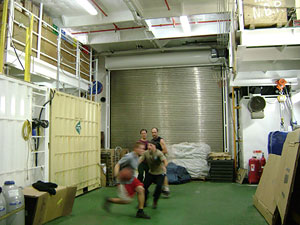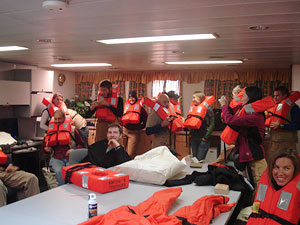

 | |||||||||||
|
|
Journals 2008/2009Roy Arezzo
July 11, 2008 Last night was an important night for the success of our mission. We spent about forty minutes with a small hand truck moving and stacking crates and gear, again, so that we could clear the area under the net for some old school halfcourt basketball. "Half court" is a bit of a generous description for the space we are using. The "helo hanger" is not the ideal place to play but with high ceilings, a steel floor, a bay door that shuts and a backboard; it is the only place in the southern ocean we can shoot hoops and not catch hypothermia. Both principal investigators are over 6-feett and they battle on the court as if the Nobel Prize depended on it. I spent a fair amount of time staying out of their way so they can score points. I enjoyed a good sweat and was hoping to adjust to the rolling of the ship and the smaller rim but that has not happened yet. It was good that no one was keeping stats. For those not up for the court battles we have an on-board gym to keep the body working and the mind clear for life at sea.
As for science work there is much setting up of computer systems, prepping chemical solutions and final touches on some of the instrumentation. We had our first science meeting and it was amazing to hear all the projects that will be going on this cruise. I don't think it is digestible to report on all the sampling methods we will employ this trip in one journal entry so stay tuned for more on what we are doing as projects unfold. I especially look forward to working and writing about the "MEGACORE". I am excited to be able to say we "deployed a Megacore," but who wouldn't be? I am scheduled to work on the 12 p.m. to 12 a.m. shift which means I have very little acclimating to do and will be up for much of the limited day light hours we have ahead of us. My contact for this cruise, Craig Smith, will be working the night shift, so I look forward to working with the PI, David DaMaster, who will be lead scientist on my watch. We have been issued evacuation plans in the event of an emergency, tried on our survival suits and boarded the not so cushy rescue boat. More drills lie ahead. Much of the team has been at sea before and seemed comfortable getting in and out of their "Gumby" suits.
The ship has left the protected waters of the Strait of Magellan and although the seas are relatively calm we are moving out of site of land and the ship rolls quite a bit. I have decided to go seasickness meds free and I am feeling good but, the movement of the ship turns out to be less conducive to journal writing than I had hoped. I am fortunate that I can always find an editor around willing to volunteer for the laborious task of smoothing out my drowsy writing. We had our last view of land until we are the vicinity of Antarctica and a few of us went out on the bow and photographed the mountains of Tierra del Fuego, Chile. We saw a few seals before we left and a few porpoises have run along side the ship, but outside on deck is very quiet. The galley crew is feeding us well and we expect another three days of transit depending on weather conditions and sea ice. Top speed of this icebreaker is about 11 knots since she is built more for muscling through ice than cruising open water. She is home and we all are getting accustomed to our new surroundings. |
||||||||||

